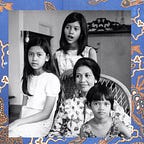Ratmini: Batik as Longing
On a hot muggy day in Jakarta, back in March 2013, 88 year-old Ratmini was busy laying-out her collection of batik on the living room table. She had been asked to do a short presentation about batik to members of the Women’s International Club in Jakarta. The family, however, never had seen her collection of 100 plus pieces of batik, usually folded neatly in her wardrobe, laid out on the table in piles by origin. We asked her to repeat her presentation for the family. So that Sunday morning, the children, grandchildren and nieces and nephews gathered at our home in Jalan Tanjung to hear the stories about her collection.
Luckily, we had the foresight to video tape the session. Among the pieces she spoke about where the unique designs created by Ratmini’s father, Sudirman Gandasubrata, a judge in colonial Dutch Indies. [“He was a judge, but he was always poor,” recalled Ratmini.] After he retired, he created designs on thin tracing paper, which he handed over to his wife, Satinah (Seneng), who then applied the designs with wax on a piece of cotton fabric, transforming them into beautiful batik pieces.
One of their special designs was made for their fourth child (Ratmini) which they named Onengan — a play on Ratmini’s nick name Sri Oneng, which means “longing.” Ratmini’s grandfather named her Sri Oneng because she was born 10 months after her father returned from studying law in Leiden, as a testament of his longing for his wife, Seneng.
Ratmini has kept, in its original olive green tin box, 124 designs created by her grandfather, Sudirman Gandasubrata. She remembered how sometimes her parents would bring the cloth, already applied with wax, using the design made by her father to a batik shop to help with the dyeing process. When they came back to the shop months later, they noticed that when the shop-owners liked their design, they had made a “cap” [read: chap] or copper stamp to create more batik using their design. Ratmini said her mother was not happy at first, but Sudirman said, “It’s fine. It will make the design more popular.” Decades later, Ratmini returned to the few remaining batik shops in Banyumas, and was able to purchase batik with the Parang Gandasubrata motif. Her father combined the Madubronto motif with Parang Gandasuli.
Ratmini also asked her mother to create a batik design to reflect her love for the ocean and sailing. She created two. One in the traditional brown and white batik colours depicting fish, shrimp and other sea creatures, which Seneng named Iwak-Iwakan (Fishes). The second one a deep blue ocean background dotted with fantastic marine animals. This motif she called Segaran (Ocean.)
Please watch Ratmini’s full presentation of her batik collection in these videos (Part 1 and 2), uploaded on Youtube with the help of Mas Janu, a Banyumas art-enthusiast and friend!
Happy birthday, Ratmini! Celebrating 96 years of love and creativity on 18 November.
